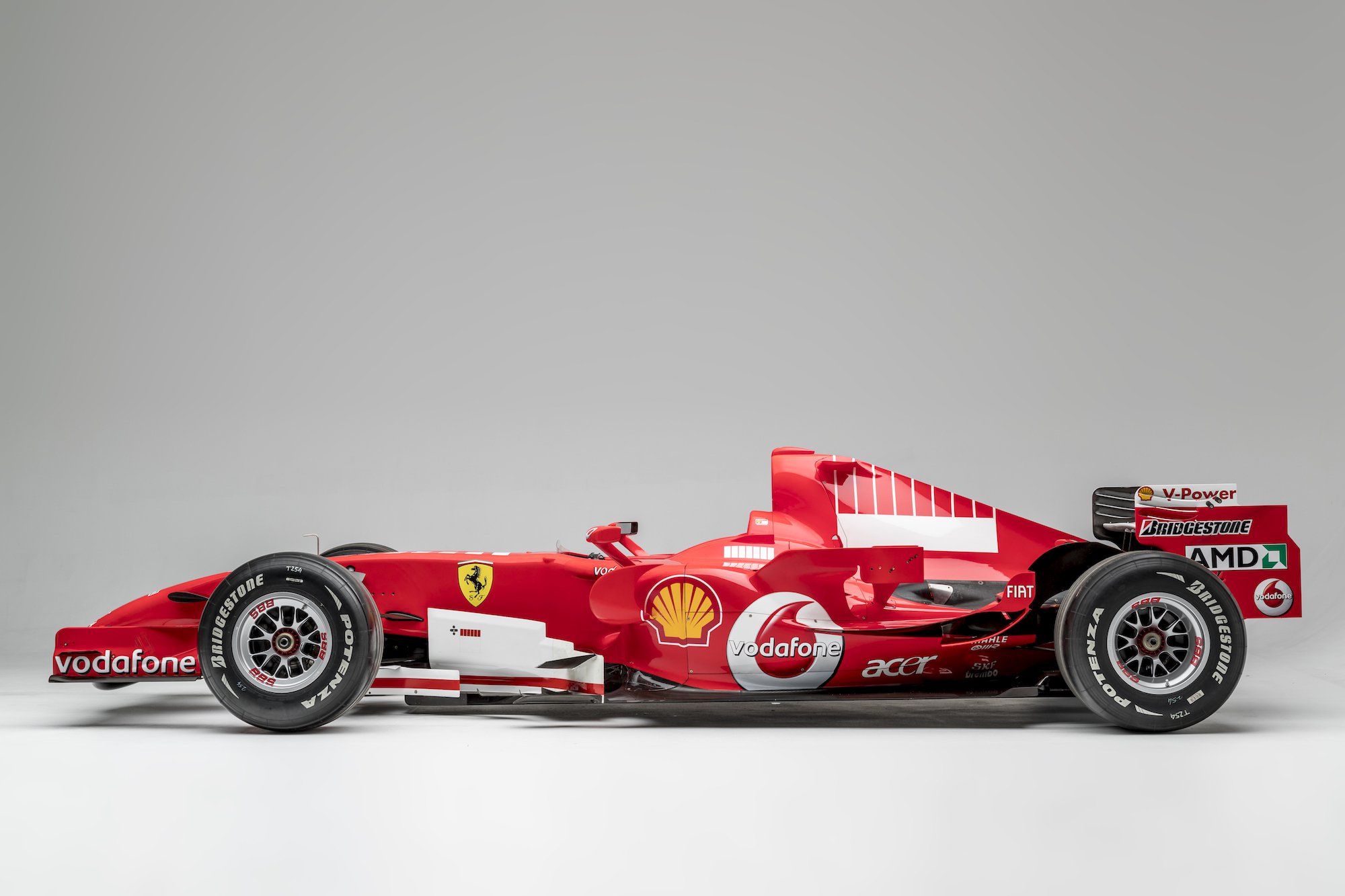2006 Ferrari 248 F1

The descriptions of the Classic Cars in the Directory were partly generated or supplemented with the help of artificial intelligence (AI). The content may occasionally not always be entirely accurate or factually correct despite careful checking.
The Ferrari 248 F1 2006 boasts of impressive technical features that make it a top-of-the-line racing machine. It was designed to participate in the 2006 Formula One season, and it proved to be a dominant force on the track. The technical details of this Ferrari 248 F1 are a testament to its engineering excellence and racing pedigree.
The Car Design
Starting from its design, the Ferrari 248 F1 was a sleek and aerodynamic marvel. It has an elongated and narrow nose that reduces the frontal area, thus reducing the car’s air drag. The sidepods are also smaller and more streamlined, which further enhances the car’s aerodynamics. The car's weight distribution was also meticulously planned, placing the engine and other heavy components low to the ground to lower the center of gravity.
Engine and Performance
The Ferrari 248 F1's mid-mounted 2.4-liter V8 engine pumps out an impressive 750 horsepower. This engine's powerful output is due to the advanced and innovative engine technology that Ferrari put in place to improve performance. It uses an 90-degree angle and four-valve-per-cylinder layout, which makes it both compact and powerful. With the engine's high rotational speed and its advanced valve train system, the 248 F1 can reach speeds of over 200 mph.
The 248 F1's engine is mated to a seven-speed, semi-automatic transmission with paddle shifters. The gearbox's advanced design enables drivers to change gears quickly and seamlessly, allowing them to react fast to any situation on the track.
Suspension and Brakes
The suspension of the Ferrari 248 F1 was designed to improve the car's grip on the track. It features double-wishbone suspension with inboard mounted torsion bar springs and dampers. This innovative suspension system provides precise handling, reducing the car's tendency to understeer or oversteer.
To complement the balanced suspension system, the 2006 Ferrari 248 F1 is equipped with advanced braking technology. The car features carbon-fiber brake discs that provide exceptional stopping power. The brake system's lightweight design reduces the car's overall weight, enabling it to react more quickly and smoothly to driver inputs.
Technical Features
The Ferrari 248 F1's technical features were advanced for its time, making it a standout racing machine. The car's electronically controlled differential enables drivers to optimize the car's grip on the road. The car's steering system was also advanced, providing unparalleled precision and feedback to the driver.
The car's telemetry system was one of the most advanced of its kind at the time. It allowed engineers to continuously monitor and analyze the car's performance using real-time data. This data enabled the team to fine-tune the car's settings precisely to improve its on-track performance further.
Conclusion
In conclusion, the Ferrari 248 F1 2006 is a beautifully designed and engineered racing machine that showcases Ferrari's immense technical expertise. Its impressive engine, transmission, suspension, brakes, and technical features are a testament to Ferrari's commitment to high-performance racing. The Ferrari 248 F1 remains as a piece of motorsport history, a true masterpiece of engineering and innovation of its time.
Milestones
- February 23, 2006: The Ferrari 248 F1 is unveiled to the public. - March 12, 2006: The car makes its debut in the Bahrain Grand Prix, with drivers Michael Schumacher and Felipe Massa. - May 7, 2006: Schumacher wins the European Grand Prix in Nürburgring, marking the first victory for the 248 F1. - July 16, 2006: Schumacher wins the French Grand Prix, bringing his season total to four victories. - August 27, 2006: Both Ferrari drivers finish on the podium at the Turkish Grand Prix, with Schumacher in second place and Massa in third. - October 8, 2006: Schumacher earns his eighth and final victory of the season at the Japanese Grand Prix. - October 22, 2006: Ferrari clinches the Constructors' Championship at the Brazilian Grand Prix, with one race remaining in the season. - November 5, 2006: Schumacher earns his second-place finish at the Brazilian Grand Prix, securing his seventh and final Drivers' Championship title. - November 19, 2006: The season ends with the final race in Brazil, with Ferrari finishing as Constructors' Champions and Schumacher as Drivers' Champion.Technical
- Engine: 2.4 L V8 - Power Output: 740 hp at 19000 RPM - Drivetrain: Rear-wheel drive - Transmission: 7-speed semi-automatic - Weight: 600 kg (including driver) - Suspension: Independent suspension - Brakes: Brembo disk brakes - Fuel system: Magnetti Marelli electronic fuel injection - Steering: Rack and pinion - Wheelbase: 3050 mm - Front track: 1470 mm - Rear track: 1400 mm - Tires: Bridgestone Potenza